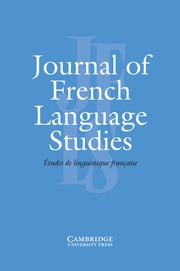Article contents
Synchronic variation in the expression of French negation: A Distributed Morphology approach
Published online by Cambridge University Press: 19 November 2013
Abstract
This article discusses ne-variation in French sentential negation based on the phonologically transcribed corpus T-zéro (cf. Meisner, in preparation) which allows a new interpretation of the facts. In the last decades, sociolinguistic and stylistic approaches to linguistic variation in French (cf. Armstrong, 2001) have shown that extra-linguistic factors, such as the speaker's age, sex, social background or geographic origin as well as the communication situation may have considerable influence on variable ne-omission. However, in contrast to most sociolinguistic studies dedicated to this phenomenon (cf. Ashby, 1976, 1981, 2001; Armstrong and Smith, 2002; Coveney, 2002) we will focus on the linguistic factors influencing ne-variation, since their importance is empirically evident but not yet fully exploited on a theoretical level.
One leading assumption with respect to ne-variation in literature is that the particle ne is most frequently retained in combination with a proper name or a full DP and is commonly omitted when combined with clitic subjects. However, there are many exceptions to this rule which, as we argue, can be better explained by considering the phonological form of the involved subject. Ne-realisation is treated here as an inner-grammatical phenomenon that is triggered by context sensitivity with regard to the element to its left, i.e. usually the grammatical subject, and not as a consequence of ‘code-switching’ between two grammars nor as a sociolinguistic variable characterising certain groups of speakers in the Labovian sense (cf. Labov, 1972), since we seek to describe general variational tendencies, present in nearly all speakers of contemporary European French. Our analysis, which is implemented in a Distributed Morphology framework (Halle & Marantz, 1994), is compatible, however, with stylistic approaches to ne-variation, such as audience design (cf. Bell, 1984, 2001).
Information
- Type
- Articles
- Information
- Journal of French Language Studies , Volume 24 , Issue 1: Negation and Clitics in French: Interaction and variation , March 2014 , pp. 9 - 28
- Copyright
- Copyright © Cambridge University Press 2013
References
REFERENCES
- 14
- Cited by

